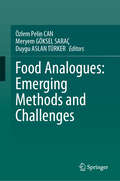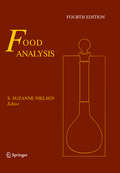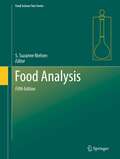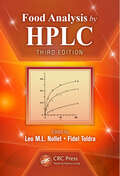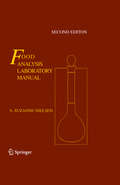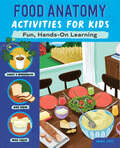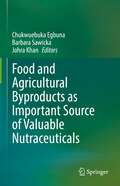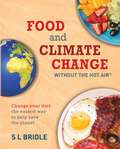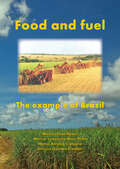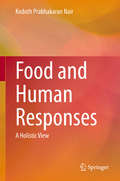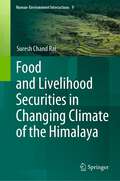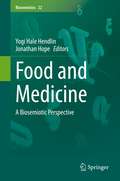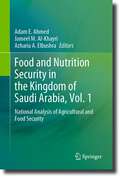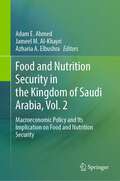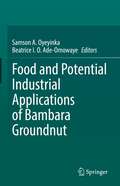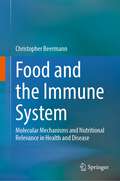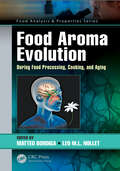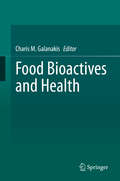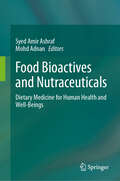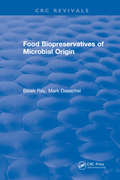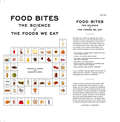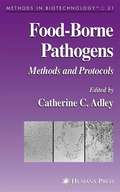- Table View
- List View
Food Analogues: Emerging Methods and Challenges
by Özlem Pelin Can Meryem Göksel Saraç Duygu Aslan TürkerAs vegetarian and vegan diets have taken hold across the Western world in recent years, the food industry has in turn seen a burgeoning demand for plant-based substitutes, known as analogues. Consumers are hungry for a product that aligns with their values, meets their nutritional needs, and also delivers on its promise of simulating the qualities of its target food item, be that beef, chicken, egg or dairy. Researchers are thus continually working to more closely approximate not only the taste but also the aesthetic, textural and rheological properties of the food item they are imitating. Meanwhile, questions about the nutritional content and environmental impact of food analogues are also of major interest for conscious consumers. While existing volumes have covered specific analogues such as meat or dairy, Food Analogues: Emerging Methods and Challenges will be the first to offer an authoritative overview of all food analogues and comprehensively assess the current and future state of the industry. This text covers both the fundamental processes of textural manipulation and sensory evaluation as well as the microbiological and regulatory aspects of these plant-based substitutes. Looking towards the future of food analogue technology, it will also discuss promising new approaches such as the use of 3D printing and edible insects in analogue production. This book will be of value to researchers, manufacturers, regulators, nutritionists, and even consumers themselves, seeking to make more informed decisions about their diets.
Food Analysis
by S. Suzanne NielsenThis book provides information on the techniques needed to analyze foods in laboratory experiments. All topics covered include information on the basic principles, procedures, advantages, limitations, and applications. This book is ideal for undergraduate courses in food analysis and is also an invaluable reference to professionals in the food industry. General information is provided on regulations, standards, labeling, sampling and data handling as background for chapters on specific methods to determine the chemical composition and characteristics of foods. Large, expanded sections on spectroscopy and chromatography also are included. Other methods and instrumentation such as thermal analysis, ion-selective electrodes, enzymes, and immunoassays are covered from the perspective of their use in the analysis of foods. A website with related teaching materials is accessible to instructors who adopt the textbook.
Food Analysis (Food Science Text Series)
by S. Suzanne NielsenThis fifth edition provides information on techniques needed to analyze foods for chemical and physical properties. The book is ideal for undergraduate courses in food analysis and is also an invaluable reference to professionals in the food industry. General information chapters on regulations, labeling, sampling, and data handling provide background information for chapters on specific methods to determine chemical composition and characteristics, physical properties, and objectionable matter and constituents. Methods of analysis covered include information on the basic principles, advantages, limitations, and applications. Sections on spectroscopy and chromatography along with chapters on techniques such as immunoassays, thermal analysis, and microscopy from the perspective of their use in food analysis have been expanded. Instructors who adopt the textbook can contact the editor for access to a website with related teaching materials.
Food Analysis by HPLC
by Leo M.L. Nollet Fidel ToldráFor food scientists, high-performance liquid chromatography (HPLC) is a powerful tool for product composition testing and assuring product quality. Since the last edition of this volume was published, great strides have been made in HPLC analysis techniques-with particular attention given to miniaturization, automatization, and green chemistry. Tho
Food Analysis Laboratory Manual
by S. Suzanne NielsenThis second edition laboratory manual was written to accompany Food Analysis, Fourth Edition, ISBN 978-1-4419-1477-4, by the same author. The 21 laboratory exercises in the manual cover 20 of the 32 chapters in the textbook. Many of the laboratory exercises have multiple sections to cover several methods of analysis for a particular food component of characteristic. Most of the laboratory exercises include the following: introduction, reading assignment, objective, principle of method, chemicals, reagents, precautions and waste disposal, supplies, equipment, procedure, data and calculations, questions, and references. This laboratory manual is ideal for the laboratory portion of undergraduate courses in food analysis.
Food Anatomy Activities for Kids: Fun, Hands-On Learning (Anatomy Activities for Kids)
by Amber K. StottA hands-on guide to the world of food science for kids ages 8 to 12 The meal on your plate has had many adventures on its way to your belly! Uncover the mysteries of the food you eat with Food Anatomy Activities for Kids, a kids' guide to the incredible history, science, and culture of food. It's packed with easy-to-understand lessons, fun recipes, and engaging experiments to make you feel connected to the food you eat—and make your mouth happy! Travel on a food journey around the world, taste new things, and learn fun facts. Find out all about foods that are foraged or farmed, sweet or savory, baked or preserved—and don't forget foods that you drink! Get involved by predicting the answers to questions, testing your ideas, and drawing conclusions just like a real food scientist. Inside Food Anatomy Activities for Kids, you'll: Follow the life of food—Discover colorfully illustrated lessons on the history and uses of 20 different types of foods. Try awesome activities—Dive into cool experiments like preserving egg yolks with salt, making butter in a mason jar, and growing new fruit from leftover seeds. Think like a scientist—Grab your own notebook and write down your discoveries with the help of in-depth journal prompts after every activity. Take a trip through the wonderful world of food with Food Anatomy Activities for Kids!
Food and Agricultural Byproducts as Important Source of Valuable Nutraceuticals
by Chukwuebuka Egbuna Barbara Sawicka Johra KhanFood and agricultural by-products are leftovers or wastes from parts of foods, fruits, vegetables and animal sources which are obtained after processing. Agricultural by-products includes peels and rinds from citrus fruits, pineapple, mango, and banana. Other notable ones are pomace from apple, olive, red beet, and those from wine making. Also, whey from milk, straws, hulls, and brans from grains are among top agricultural by-products. These by-products often impact the environment and the social-economic sectors when they are disposed. But with the recent advances in biotechnology and scientific research, scientists have found usefulness in some of these byproducts as sources of valuable nutraceuticals, a term used to refer to chemical entities present in foods that has the propensity to impact health for disease prevention and treatment. This book entitled ‘Food and agricultural by-products as important source of valuable nutraceuticals’ presents detailed information about major agricultural byproducts that are rich in nutraceuticals. The nature and the type of nutraceuticals that they contains and their health promoting benefits were presented. The editors and chapter contributors are renowned experts from key institutions around the globe. This book will be useful to students, teachers, food chemists, nutritionists, nutritional biochemists, food biotechnologists among others. Key features Ø Highlights the health promotion benefits of nutraceuticals Ø Presents information on agrifood by-products as sources of nutraceuticals Ø Discusses functional nutraceuticals from peels, rinds, pomace, hull, bran etc
Food and Climate Change without the hot air: Change your diet: the easiest way to help save the planet (without the hot air #8)
by S L Bridle• 25% of greenhouse gas emissions come from food – how can we reduce this? • What effect does the food we eat have on the environment? • How will climate change affect the food we will eat in the future? • Can the choices we make as consumers reduce carbon emissions dramatically? Inspired by the author's former mentor David MacKay (Sustainable Energy Without the Hot Air), Food and Climate Change is a rigorously researched discussion of how food and climate change are intimately connected. In this ground-breaking and accessible work, Prof Sarah Bridle focuses on facts rather than emotive descriptions. Highly illustrated in full colour throughout, the book explains how anyone can reduce the climate impact of their food.
Food and Fuel: The example of Brazil
by Marcos Fava Neves Vinicius Gustavo Trombin Mairun Junqueira Alves Pinto Marco Antonio ConejeroThis book is a contribution of the authors to the food - fuel debate. During 2007 and 2008 several factors led to the food inflation problem: growing population, income distribution, urbanization, biofuel, social programs, production scarcity etc.. Biofuel got most of the blame for food inflation but its responsibility was only limited. There are several possibilities of solving the food inflation problem that are discussed this book. It explores the example of Brazil's agricultural sector, where a quiet revolution occurred in the last 15 years. This development is leading to Brazil becoming one of the largest food exporters globally. This position will strengthen as an additional 100 million hectares becomes available for crop development. The second part of the book explores the basics of the sugar cane chain. Sugar cane occupies less than 2% of Brazilian arable land and supplies 50% of Brazilian car fuel. In 2010 Brazil produced 53% of the world's sugar. Sugar cane produces sugar, ethanol (used as car fuel), biogases that are used to co-generate electricity and other by-products. Biofuel is a booming industry. New technologies allow production of diesel and other fuels from cane. Sugar cane ethanol is the only renewable fuel that can currently compete with gasoline. Coca Cola just launched the plastic bottle with sugar cane plastic. This book helps us to understand Brazilian agribusiness and sugar cane economics from various perspectives e.g. international investments, sustainability, future trends and the strategic plan for the Brazilian industry.
Food and Human Responses: A Holistic View
by Kodoth Prabhakaran NairThis book discusses the role of food and the human nutrition-behavior interface. Food makes us what we are, but in addition to providing adequate nutrition, does it influence behavior? This book looks at this critical question from various angles and considers different concepts and approaches to food, nutrition and well-being. To better understand the entire gamut of the food-behavior linkage, the author unravels the workings of the mind - brain link. The book discusses this aspect and the findings add to the existing fund of knowledge in this area. Much of today’s malaise in humans can be traced to the food consumed by individuals. This book provides a comprehensive picture of the current state of human nutrition and how this can be linked to behavior.
Food and Industry 5.0: Transforming the Food System for a Sustainable Future (Sustainable Development Goals Series)
by Pushan Kumar Dutta Ahmed Hamad A. K. Haghi Pranav Kumar Prabhakar"Food and Industry 5.0: Transforming the Food System for a Sustainable Future" offers a groundbreaking exploration of cutting-edge technologies reshaping the global food landscape. This comprehensive volume delves into innovations driving the fifth industrial revolution in food production and distribution. The book examines nanotechnology and biosensor applications in food processing and safety, analyzing their potential to revolutionize quality monitoring, extend shelf life, and enhance traceability. It unveils the transformative power of artificial intelligence and machine learning across the food value chain, from plant disease detection to sustainable poultry production. Significant attention is given to the integration of Internet of Things (IoT) and digital twin technology in agriculture and food supply chains, offering insights into real-time monitoring, predictive maintenance, and optimization techniques. The text explores robotics in food manufacturing, emphasizing advancements in efficiency, waste reduction, and safety. Crucial methodologies for quantifying and analyzing complex agricultural data are addressed, presenting both regression and classification approaches in precision agriculture. Sustainability is a key focus, with chapters examining nano-fertilizers, soil amendments, and AI-integrated crop systems designed to advance UN Sustainable Development Goals. Blockchain technology's role in enhancing food traceability and safety is investigated, complete with real-world case studies. The book addresses the complex regulatory landscape surrounding Industry 5.0 technologies, including waste management in hospitality and ethical considerations of AI deployment. Concluding chapters offer forward-looking analyses of emerging trends in dairy, diet, and hospitality subsectors. This meticulously researched volume employs a wide array of methodologies, from experimental studies to economic modeling and qualitative research. "Food and Industry 5.0" is an indispensable resource for food scientists, agricultural researchers, computer scientists, policymakers, and industry professionals. By bridging multiple disciplines, it provides a scientifically rigorous, data-driven roadmap for creating a more sustainable, efficient, and ethical global food system.
Food and Livelihood Securities in Changing Climate of the Himalaya (Human-Environment Interactions #9)
by Suresh Chand RaiThis book provides viewpoints on a cross-sectoral, multiscale assessment of food and livelihood security in changing climate, the main global threats of the 21st century. Climate change, directly and indirectly, influences several aspects of food security, primarily in the farming and livestock sectors. The farming sector is the main source of income and employment for about 70% of the Himalayan populace. However, there has been no such study that has comprehensively covered these aspects.Additionally, the book offers critical mitigation measures to adapt to climate change and other uncertainties. The agricultural diversities and livelihood security in the Himalayan region will be sustainable only if farmers applied suggested mitigation measures correctly.This title is appropriate for postgraduates and research scholars of social sciences, environmental sciences, and agricultural sciences. Regional planners, government officers, NGOs, and many other people who are interested in the Himalayan region as well as local communities will be also beneficial.
Food and Medicine: A Biosemiotic Perspective (Biosemiotics #22)
by Yogi Hale Hendlin Jonathan HopeThis edited volume provides a biosemiotic analysis of the ecological relationship between food and medicine. Drawing on the origins of semiotics in medicine, this collection proposes innovative ways of considering aliments and treatments. Considering the ever-evolving character of our understanding of meaning-making in biology, and considering the keen popular interest in issues relating to food and medicines - fueled by an increasing body of interdisciplinary knowledge - the contributions here provide diverse insights and arguments into the larger ecology of organisms’ engagement with and transformation through taking in matter. Bodies interpret molecules, enzymes, and alkaloids they intentionally and unintentionally come in contact with according to their pre-existing receptors. But their receptors are also changed by the experience. Once the body has identified a particular substance, it responds by initiating semiotic sequences and negotiations that fulfill vital functions for the organism at macro-, meso-, and micro-scales. Human abilities to distill and extract the living world into highly refined foods and medicines, however, have created substances far more potent than their counterparts in our historical evolution. Many of these substances also lack certain accompanying proteins, enzymes, and alkaloids that otherwise aid digestion or protect against side-effects in active extracted chemicals. Human biology has yet to catch up with human inventions such as supernormal foods and medicines that may flood receptors, overwhelming the body’s normal satiation mechanisms. This volume discusses how biosemioticians can come to terms with these networks of meaning, providing a valuable and provocative compendium for semioticians, medical researchers and practitioners, sociologists, cultural theorists, bioethicists and scholars investigating the interdisciplinary questions stemming from food and medicine.
Food and Nutrition Security in the Kingdom of Saudi Arabia, Vol. 1: National Analysis of Agricultural and Food Security
by Adam E. Ahmed Jameel M. Al-Khayri Azharia A. ElbushraFood and nutrition security is a major concern for Saudi Arabia and the surrounding regions due to the range of challenges they face. These challenges include limited agricultural resources, low self-sufficiency in key food staples, climate change, and high levels of food loss and waste. This book aims to evaluate and analyze the current situation and future prospects of food and nutrition security in Saudi Arabia. Additionally, it seeks to analyze and assess the roles and functions of various institutions related to food security, providing a deeper understanding of the complex problems associated with it. Furthermore, this book aligns with Kingdom Vision 2030, which includes a set of strategies and programs focused on agriculture, food, and water security. It also aligns with the institutional identity of King Faisal University's "Food Security and Environmental Sustainability".The book consists of four volumes. Volume 1, entitled "National Analysis of Agriculture and Food Security" aims to assess the current state of food security in Saudi Arabia, covering key aspects such as agriculture and food resources, food systems, crops, livestock, poultry, fisheries, animal health, food loss and waste, transportation and strategic reserve infrastructure, food security institutions, population, agricultural extension, climate change, agricultural mechanization, smart agriculture, and the utilization of solar energy.This book is highly significant for professionals, researchers, policymakers, and entrepreneurs involved in food and nutrition security in Saudi Arabia, the Gulf Cooperation Council, and various national and international organizations. It offers a comprehensive analysis of the obstacles and possibilities in ensuring food and nutrition security, as well as presenting practical approaches to address these issues. Additionally, graduate students studying in fields related to food and nutrition security will benefit from this book.
Food and Nutrition Security in the Kingdom of Saudi Arabia, Vol. 2: Macroeconomic Policy and Its Implication on Food and Nutrition Security
by Adam E. Ahmed Jameel M. Al-Khayri Azharia A. ElbushraFood and nutrition security is a major concern for Saudi Arabia and the surrounding regions due to the range of challenges they face. These challenges include limited agricultural resources, low self-sufficiency in key food staples, climate change, and high levels of food loss and waste. This book aims to evaluate and analyze the current situation and future prospects of food and nutrition security in Saudi Arabia. Additionally, it seeks to analyze and assess the roles and functions of various institutions related to food security, providing a deeper understanding of the complex problems associated with it. Furthermore, this book aligns with Kingdom Vision 2030, which includes a set of strategies and programs focused on agriculture, food, and water security. It also aligns with the institutional identity of King Faisal University's "Food Security and Environmental Sustainability".The book consists of four volumes. Volume 2 is entitled "Macroeconomic Policy Implications on Food and Nutrition Security". It covers various areas, including food price, loss and waste, processing, finance, trade, investment, quality and safety, consumption patterns, climate change, early warning systems, nutrition institutions, oil revenue, and the significance of date palm and Hassawi rice, genetically modified food, and edible insects in ensuring food and nutritional security.This book is highly significant for professionals, researchers, policymakers, and entrepreneurs involved in food and nutrition security in Saudi Arabia, the Gulf Cooperation Council, and various national and international organizations. It offers a comprehensive analysis of the obstacles and possibilities in ensuring food and nutrition security, as well as presenting practical approaches to address these issues. Additionally, graduate students studying in fields related to food and nutrition security will benefit from this book.
Food and Potential Industrial Applications of Bambara Groundnut
by Samson A. Oyeyinka Beatrice I. O. Ade-OmowayeBambara groundnut (Vigna subterranea) is a crop native to the Bambara tribe of Mali and is grown as a subsistence crop in Africa. Recent advances in research, however, have brought the crop to the forefront of the sustainable agriculture movement.The Bambara plant is highly drought tolerant and rich in protein and carbohydrates, including starch. These macromolecules have enormous industrial potentials. For example, the starch in Bambara grain has been found to exhibit higher (double) viscosity than conventional corn starch. Modified Bambara groundnut starch has been used to produce edible bioplastics that could be upgraded industrially to suit the fourth industrial revolution shift.Bambara plants are also a natural source of soluble fiber, which is gluten-, lactose- and cholesterol-free, with potential as a stabiliser, thickener and gelling agent as well as a cryoprotectant in frozen products. The health benefits include lowering of cholesterol levels, levelling of blood glucose and as a detoxing aid. Furthermore, several researchers have explored the grain either alone or as composite with cereal and tubers for the development of value-added products.Food and Potential Industrial Applications of Bambara Groundnut presents in a clear, coherent way the research findings on Bambara grain and its status as a promising food and industrial crop.
Food and the Immune System: Molecular Mechanisms and Nutritional Relevance in Health and Disease
by Christopher BeermannNutrition is an important environmental factor for the maturation of the human immune system and essential for maintaining immunological homeostasis. Based on this, a variety of food applications with medical claims are being generated by food manufacturers worldwide in order to expand the market potential of products creating interesting linkages with other market segments, such as cosmetics and pharmaceuticals. However, in addition to the health benefits, active principles of such components often remain unexplored.This book focusses on the specific interactions between food ingredients and the immune system along the entire immune defense response. Starting from the immune barrier, through the innate and adaptive immune response, to active limitation and termination, all major mechanisms of the immune response are addressed and different biochemical, cellular and genetic interactions of components of our diet are discussed. The book presents a wealth of disease patterns for which nutritional factors are relevant and thereby provides indications for potential intervention strategies. In addition, associated food-technological aspects are discussed. Being the first of its kind, this book provides an overview of the variety of functional food components and their influence on immunological responses. Written in an accessible style, it addresses researchers, health professionals and students with different scientific backgrounds.
Food Aroma Evolution: During Food Processing, Cooking, and Aging (Food Analysis & Properties)
by Matteo Bordiga, Leo M.L. NolletOf the five senses, smell is the most direct and food aromas are the key drivers of our flavor experience. They are crucial for the synergy of food and drinks. Up to 80% of what we call taste is actually aroma. Food Aroma Evolution: During Food Processing, Cooking, and Aging focuses on the description of the aroma evolution in several food matrices. Not only cooking, but also processing (such as fermentation) and aging are responsible for food aroma evolution. A comprehensive evaluation of foods requires that analytical techniques keep pace with the available technology. As a result, a major objective in the chemistry of food aroma is concerned with the application and continual development of analytical methods. This particularly important aspect is discussed in depth in a dedicated section of the book. Features Covers aromatic evolution of food as it is affected by treatment Focuses on food processing, cooking, and aging Describes both classic and new analytical techniques Explains how the flavor perception results are influenced by other food constituents The book comprises a good mix of referenced research with practical applications, also reporting case studies of these various applications of novel technologies. This text represents a comprehensive reference book for students, educators, researchers, food processors, and food industry personnel providing an up-to-date insight. The range of techniques and materials covered provides engineers and scientists working in the food industry with a valuable resource for their work. Also available in the Food Analysis & Properties Series: Ambient Mass Spectroscopy Techniques in Food and the Environment, edited by Leo M.L. Nollet and Basil K. Munjanja (ISBN: 9781138505568) Hyperspectral Imaging Analysis and Applications for Food Quality, edited by N.C. Basantia, Leo M.L. Nollet, and Mohammed Kamruzzaman (ISBN: 9781138630796) Fingerprinting Techniques in Food Authentication and Traceability, edited by Khwaja Salahuddin Siddiqi and Leo M.L. Nollet (ISBN: 9781138197671) For a complete list of books in this series, please visit our website at: www.crcpress.com/Food-Analysis--Properties/book-series/CRCFOODANPRO
Food as Medicine: Functional Food Plants of Africa (Functional Foods and Nutraceuticals)
by Maurice M. IwuThis comprehensive book documents African plants used for functional and medicinal foods. It contains more than 60 detailed monographs of African foods, describing foods with various characteristics such as prebiotic, probiotic, satiety, immune modulation, stress-reduction, sports performance, mental acuity, sleep-supporting, metabolic syndrome, antioxidant, and unsaturated fats. Plant description, botanical names and synonyms, plant part used, habitat and distribution, folk use, nutritional content, and chemistry are all fully detailed. The book highlights indigenous African food processing technologies up to the modern era.
Food Bioactives and Health (Food Bioactive Ingredients Ser.)
by Charis M. GalanakisBioactive natural compounds have gained attention in recent years due to their potential health benefits, including reducing the risk of diabetes, cancer, and cardiovascular diseases. These benefits derive from bioactive compounds' anti-tumor, anti-inflammatory, anti-oxidative, anti-hypertensive and anti-hyperlipidemic activities, which serve in addition to their basic nutritional functions. Over the last decade, researchers have investigated the health impact of bioactive compounds in detail, and the development of food applications has attracted great interest. Consumer demand has surged for functional foods (nutraceuticals), superfoods, and tailor-made foods, generated by supplementing traditional food products with bioactive ingredients. Food Bioactives and Health offers comprehensive coverage of the properties and health effects of food bioactives in view of new trends in processing, food science and food technology. Starting with the metabolic characteristics of polyphenols, glucosinolates, and other food bioactives, the text then dives into their impact on human health and recent applications in the world of food technology. For food scientists, food technologists, and product developers looking to understand the role of food bioactives in health and develop applications in personalized nutrition, functional foods and nutraceuticals, Food Bioactives and Health serves as a one-stop reference.
Food Bioactives and Nutraceuticals: Dietary Medicine for Human Health and Well-Beings
by Syed Amir Ashraf Mohd AdnanThis book examines nutraceuticals derived from plant, animal, or microbial sources, and presenting significant opportunities for food scientists and industry professionals to develop innovative foods or food components that address future human wellness and well-being requirements. These nutraceuticals can be specifically identified as antioxidants, dietary fiber, prebiotics, polyunsaturated fatty acids, probiotics, vitamins, polyphenols, and spices. The book also intends to consolidate current research and reviews on bioactive components inherent in traditional foods, highlighting their nutraceutical significance for promoting a healthy lifestyle. Moreover, it elaborates on the potential therapeutic applications of food bioactives as next-generation nutraceuticals sourced from novel origins. Emphasis is placed on various aspects of food bioactive compounds, exploring their prospective roles in the formulation of nutraceuticals aimed at enhancing human health and wellness, while also evaluating their potential in the management and prevention of metabolic disorders. Furthermore, the volume acknowledges the clinical implications of nutraceuticals, including their prospective applications within the food and pharmaceutical industries.
Food Biopreservatives of Microbial Origin
by Bibek RayFood Biopreservatives of Microbial Origin provides basic and applied information regarding how antimicrobial metabolites of safe, food-grade bacteria (used in food fermentation) can be utilized as food preservatives. The authors discuss why biopreservation of food is important, identify the foods and microoganisms for which biopreservation is suitable, and explore the potential of bacteriocins of food-grade starter culture bacteria and the antimicrobial proteins of yeasts as possible food biopreservatives. The book is a valuable reference resource that will benefit students of food science and researchers in food industries, regulatory agencies, and advisory groups.
Food Bites
by Richard W Hartel Annakate HartelFood Bites is an easy-to-read, often humorous book on the scientific basis of the foods we eat, and answers those pesky, niggling questions such as: Is the quality of beer really affected by the type of water used? and Processed foods: good or bad? Readers will be captivated by this superbly written book, especially so as their guides are Professor Richard Hartel, professor of Food Engineering at UW-Madison, along with his daughter, AnnaKate Hartel. Professor Hartel has for the last four years penned a witty and illuminating column on all aspects of food science for the Capital Times of Madison, and his weekly wisdom has now been collected into a single publication. With a huge and growing interest in the science of food, this treasure trove of knowledge and practical information, in 60 bite-sized chunks, is sure to be a bestseller.
Food-Borne Pathogens
by Catherine AdleyA collection of readily reproducible classic and emerging molecular methods for the laboratory isolation and identification of the pathogens, viruses, and parasites that cause food-borne disease. Among the pathogens covered are specific bacteria, including Salmonella spp, Campylobacter spp., Listeria spp., and Bacillus spp.; viruses, including noroviruses and enteroviruses; and parasites, including Cryptosporidium and seafood nematode worms. The protocols follow the successful Methods in BiotechnologyTM series format, each offering step-by-step laboratory instructions, an introduction outlining the principles behind the technique, lists of the necessary equipment and reagents, and tips on troubleshooting and avoiding known pitfalls.
